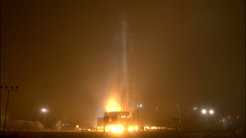InSight successfully launched
The InSight lander will reach Mars at the end of November to explore the planet’s inner structure for the first time.
NASA's InSight spacecraft has been launched successfully. Today at 1.05 pm (CEST) the space probe lifted off from Vandenberg Air Force Base in California onboard an Atlas V 401 rocket. InSight’s destination is Mars. On 26 November, 2018 the lander is scheduled to touch down on the red planet. InSight's scientific equipment includes the seismometer SEIS, to which researchers from the Max Planck Institute for Solar System Research (MPS) have contributed. The leveling system from MPS ensures that the instrument aligns itself exactly horizontally on the Martian surface, thus creating the basic prerequisite for high-precision measurements.

SEIS will be the first seismometer operating in direct contact with the Martian surface. The predecessor instruments, which collected data during the Mars missions Viking 1 and Viking 2 in the 1970s, were firmly linked to their respective landing unit. They therefore primarily registered vibrations due to the wind. SEIS will for the first time provide meaningful seismological data.
Above all, researchers want to gather information about the internal structure of our neighboring planet from this data. Like Earth, Mars is expected to have an onion-like structure of iron-rich core, silicate-containing mantle, and outer crust. However, the exact thickness and nature of these layers is still completely unclear.
In addition to the seismometer SEIS, InSight is carrying the instrument package HP3, which will examine the heat balance of Mars. The experiment RISE determines the exact position of the planet’s rotation axis. The data from all three instruments will allow conclusions about the interior of Mars.
InSight is a NASA mission. The mission is led by the Jet Propulsion Laboratory (JPL). The landing unit was built by Lockheed Martin Space. Many European partners are involved in contributing to the scientific instruments of InSight. SEIS was provided under the leadership of the French Space Agency CNES. The Institut de Physique du Globe de Paris (IPGP, France), the Swiss Federal Institute of Technology (ETH), Switzerland, the Max Planck Institute for Solar System Research (MPS, Germany), and Imperial College (UK) have contributed to SEIS. The instrument package HP3 was developed and built under the leadership of the German Aerospace Center (DLR). The experiment RISE is led by JPL.












